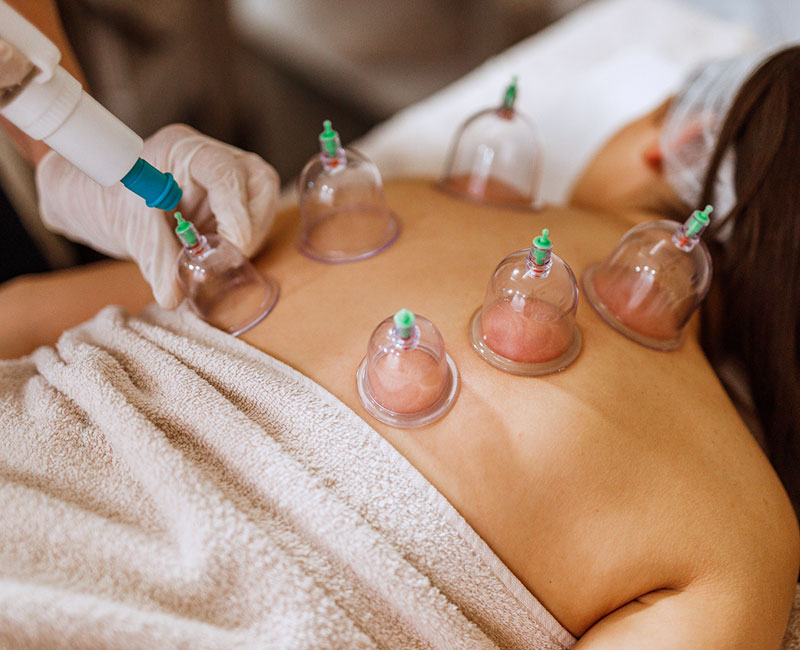Cupping therapy is an ancient healing method that may ease back pain, neck pain, headaches and other issues. It uses suction to pull on your skin and increase blood flow to the affected area. Cupping causes bruising and can lead to skin infection. There’s mixed evidence on the benefits of cupping, but the treatment risks are generally low.
Advertisement
Cleveland Clinic is a non-profit academic medical center. Advertising on our site helps support our mission. We do not endorse non-Cleveland Clinic products or services. Policy

Cupping therapy is an ancient healing technique that some people use to ease pain. A provider places cups on your back, stomach, arms, legs or other parts of your body. A vacuum or suction force inside the cup pulls your skin upward.
Advertisement
Cleveland Clinic is a non-profit academic medical center. Advertising on our site helps support our mission. We do not endorse non-Cleveland Clinic products or services. Policy
Cupping therapy is a form of traditional medicine that originated in China and West Asia. People have practiced this method for thousands of years.
Other names for cupping therapy include cupping, cup therapy and suction cup therapy.
Cupping uses suction to draw blood to or away from specific areas of your body. People mostly use cupping to relieve conditions that cause pain. Some people say it also helps with chronic (ongoing) health issues. Cupping may ease symptoms of:
Experts are still exploring how cupping eases pain and disease symptoms. There isn’t a lot of research on the therapy.
Suction from cupping draws fluid into the treated area. This suction force expands and breaks open tiny blood vessels (capillaries) under your skin. Your body replenishes the cupped areas with healthier blood flow and stimulates proper and normal healing at a cellular level. Because of this effect, some people think that cupping releases toxins.
Advertisement
There are different ways to do cupping. The steps vary slightly depending on the chosen method. Your provider will leave the cups in place for several minutes. Some treatments involve briefly moving the cups to stretch and massage the area.
Cupping methods include:
Depending on the treatment, your provider may place multiple cups on your skin. On average, providers use between three and five cups, though they might use up to seven. It’s uncommon to get more than seven cups in a single treatment.
Most providers use glass or plastic cups, but cups may also be:
The suction force from cupping breaks open tiny blood vessels called capillaries under your skin. You’ll have red, round cupping therapy marks that should fade in a week or two. Although these marks will look like bruises, they’re not true bruises that injure muscle fibers.
Cupping shouldn’t cause pain, though you may experience some skin tightness during the procedure. After cupping therapy, you may feel bruised and slightly sore, but you shouldn’t have severe discomfort.
A variety of healthcare providers can receive training to perform cupping, including:
Many people who’ve had cupping therapy report that it:
Cupping is a relatively low-risk therapy. Still, you may experience:
In rare instances, people may develop vasovagal syncope (fainting after a drop in your blood pressure and heart rate). This is most common after wet cupping for people who pass out with needle sticks.
Advertisement
Because researchers know so little about cupping’s effects on pregnancy, you shouldn’t have cupping therapy if you’re pregnant. You should also avoid cupping if you have:
Even though cupping therapy carries a low risk of complications, it’s not for everyone. Talk to your healthcare provider before trying cupping or any other alternative medical treatment.
There’s mixed evidence about the effectiveness of cupping. Experts note many different reasons why cupping might work. In fact, the success of cupping may result from a combination of these reasons.
For example, cupping therapy might:
Most healthcare providers recommend cupping as a complementary medicine treatment. In other words, you should use it in combination with traditional Western medicine rather than as a stand-alone procedure.
Advertisement
You should call your healthcare provider if you get cupping and experience:
If you’re thinking about trying cupping therapy, here are a few questions you might want to ask your healthcare provider:
People have used cupping therapy to relieve pain, headaches and other symptoms for thousands of years. While there’s not a lot of research to back up claims of success, cupping seems to work for some people — and it doesn’t carry a lot of risks. Still, you should talk to a healthcare provider before trying cupping or any alternative therapy. Your provider may be able to recommend a practitioner or specialist who can provide the alternative therapy and do so effectively and safely.
Advertisement
When you want to balance your body, mind and spirit, Cleveland Clinic holistic medicine providers can help you get in sync.

Last reviewed on 06/07/2023.
Learn more about the Health Library and our editorial process.